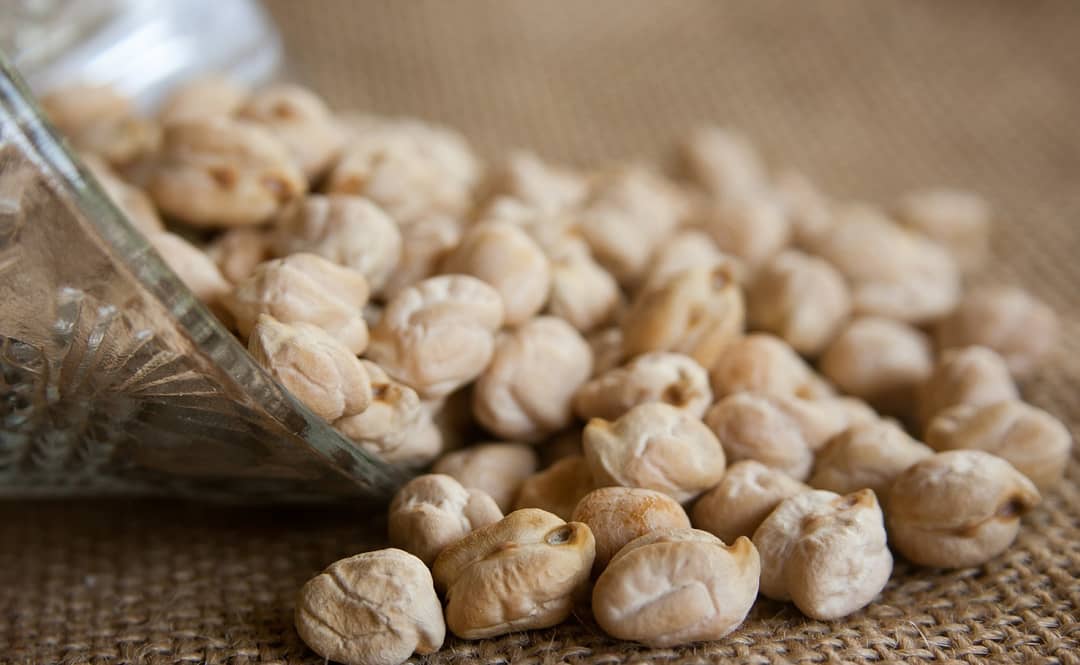Chickpeas are far more than inconspicuous legumes with a funny name. They can be used to conjure up delicacies such as hummus and falafel. Chickpeas have an extremely positive effect on digestion, the cardiovascular system and the blood sugar level. The small nutrient bombs have been eaten for about 8000 years, because they contain a lot of proteins, minerals and trace elements. They are rich in B vitamins and fibre: A perfect choice for all vegans, health and nutrition conscious people.
The chickpea – A cheerful legume
As cheerful as the name of the chickpea (cicer arietinum) may sound, its name has nothing to do with the giggling itself.
It is derived from the Latin word “cicer”, which originally means pea. So there was nothing to laugh about when it came to the name, although one could smile about the fact that we actually call the chickpea “pea-pea”.
The wrinkly legumes were cultivated already before approximately 8000 years in Asia Minor and began its triumphal procession from there to India and the Mediterranean-region.
The chickpea finally came to us with the merchant ships in the early Middle Ages – and it has remained to this day, because its buttery-nut-like taste blends harmoniously into many dishes and gives them the popular oriental note.
Particularly well-known are culinary delights such as hummus (pureed chickpea puree), falafel (fried chickpea balls) or curry dishes with a base of chickpeas.
In many regions of the world, chickpeas – together with other legumes – are a staple food. Especially in Mexico and India, they are valued for their outstanding combination of nutrients and their low price.
The chickpea and Hildegard von Bingen
Already in the writings of Hildegard von Bingen (1098 to 1179) the chickpea is mentioned. The nun and scholar recognized the qualities of the legume and its positive effects on the entire body, especially in fever.
In the health teachings of St. Hildegard, the following can be read about chickpeas:
“The chickpea is warm and pleasant and easy to eat, and it does not increase the bad juices of the one who eats it. But he that hath a fever fry chickpeas over fresh coals, and eat them, and he shall be healed.”
In the meantime, however, there is also numerous scientific evidence for the health-giving properties of chickpeas, so that today we no longer have to rely solely on Hildegard’s prophecies.
The chickpea is even considered so healthy that even all health organisations recommend the regular consumption of chickpeas.
Eat chickpeas – daily as well!
According to the American Diabetes Association, the American Heart Association and the American Cancer Society, legumes are among the foods that can help prevent disease and improve health.
One portion corresponds to about 40 grams of dried or 100 grams of cooked legumes.
In the American nutrition guidelines from 2005, which were jointly developed by the US Ministries of Health and Agriculture, significantly higher consumption recommendations can be found.
It lists 3 cups of legumes per person per week, which corresponds to about 600 grams of cooked legumes per week.
In many studies, even larger quantities are recommended, 200-400 grams of cooked legumes per day, on the grounds that increased consumption of legumes is associated with more stable health and increased performance.
If you look at the properties of chickpeas, it is no wonder.
The nutrients and vital substances of chickpeas
Just one portion of cooked chickpeas (approx. 165 g) covers
70 percent of the daily folic acid requirement
65 percent of the daily copper requirement
50 percent of the daily dietary fibre requirement
25 percent of the daily iron requirement
20 percent of daily zinc requirements
The whole thing naturally with a low glycemic index (GI) and moderate calorie intake.
Chickpeas have a particularly positive effect on digestion due to their high fibre content.
Chick peas for healthy digestion
Two thirds of the chickpea fibre is insoluble. They thus pass through the digestive tract unchanged until they reach the large intestine. On their way they help to stimulate intestinal peristalsis, clean the intestines and maintain a healthy intestinal environment.
In the last section of the intestine, the bacteria of the large intestine break down the indigestible fibres into short chain fatty acids such as acetic acid, propionic acid and butyric acid.
These short-chain fatty acids are absorbed by the cells of the colon wall and used as a source of energy.
The dietary fibres of chickpeas are therefore exceptionally good for keeping the intestinal mucosa healthy, which in turn can significantly reduce the risk of colon problems, including colon cancer.
Antioxidants are also known to prevent cancer. Here, too, the chickpea can keep up very well.
Chickpeas have an antioxidant effect
Many of our body systems are susceptible to oxidative stress and damage caused by reactive oxygen molecules. Our cardiovascular system, our lungs and our nervous system are all affected.
But antioxidants help against oxidative stress – and these can also be found in large quantities in chickpeas.
The chickpea, for example, provides only small amounts of the known antioxidants such as vitamin C, vitamin E and beta-carotene. However, the chickpea instead contains secondary plant substances with a high antioxidant potential.
These include the flavonoids quercetin, Kaempferol and myricetin as well as various phenolic acids. They form an important support to protect the body from attacks by free radicals and reactive oxygen compounds.
Chickpeas also contain relatively large amounts of manganese – a trace element found in the energy-producing mitochondria of most cells and thus involved in energy production. Manganese is also an important component of the body’s own antioxidant enzymes, such as superoxide dismutase.
One portion of chickpeas already covers 85 percent of the daily manganese requirement.
The knowledge about the antioxidative abilities of the Kichererbsse led to ever more studies at animals and humans, which could show in detail that the benefit of Kichererbsen reduces among other things the risk of heart illnesses. Finally, antioxidants keep blood vessels elastic and improve blood flow.
However, chickpeas – consumed regularly – also reduce blood lipid levels.
Chickpeas protect the heart and circulatory system
If you want to improve your blood lipid levels and thus your heart and vascular health, you should always think of chickpeas. It counteracts arteriosclerotic changes in several ways and thus reduces the risk of developing coronary heart disease.
The high saponin content of the chickpea (50 mg per kilogram of chickpeas) is mainly responsible for the blood lipid-lowering effect of the tasty legume.
Saponins combine with the cholesterol molecules in food to form insoluble complexes so that they cannot enter the bloodstream via the intestines. In addition, saponins bind bile acids to themselves, so that the liver has to make use of the body’s cholesterol reservoirs to form new bile acids, which lowers the cholesterol level.
The extremely swellable dietary fibres of chickpeas also help to lower cholesterol levels.
Similar to saponins, dietary fibres bind to fats in the intestine so that they do not get into the blood but are simply excreted in the stool.
Consequently, it is not surprising that large-scale epidemiological studies on health and nutrition research have shown that even 150 grams of cooked chickpeas per day can help to significantly reduce LDL (“bad” cholesterol) levels and total cholesterol levels as well as triglyceride levels within a month.
In practice, chickpeas also regulate the blood sugar level due to their high fibre and protein content, which is particularly interesting for diabetics and for people with incipient insulin resistance.
Chick Peas – Perfect for Diabetes
Chinese scientists have found that chickpea can contribute both to healthier pancreatic function (increased insulin secretion) and to a reduction in insulin resistance.
In an Australian study, chickpeas showed similar blood sugar regulating effects. Here the test persons ate at least 728 gram of canned chickpeas per week. In the result already within one week smaller blood sugar values were measured than before.
This effect does not only come humans with diabetes to property, but all, which have to fight frequently with blood sugar fluctuations or hot hunger attacks as well as persons, who would like to decrease. Because the less hot hunger attacks and the more balanced the blood sugar mirror, the more easily also the weight decrease succeeds.
Full and slim with chickpeas
Studies have also shown that chickpeas saturate very well.
The participants in the most recent study found that they nibbled much less between meals and ate fewer calories in the daily balance if they had eaten chickpeas. The test persons reported a higher degree of saturation, which led to a reduced appetite and reduced the number of snacks.
Moreover, since the chickpea is quite low in calories (100 g cooked chickpeas have only 120 kcal), it is an ideal support for those who have not yet reached their ideal weight. At the same time, the chickpea is an excellent source of protein, which is particularly interesting for people whose diet excludes other protein sources, such as vegans or vegetarians.
Chick Peas – The Top Protein Source
Just one portion of cooked chickpeas (approx. 220 g) provides 20 grams of protein and can therefore compete well with typical animal protein sources.
For comparison, 100 grams of chicken breast fillet contain 16 grams of protein, 100 grams of pork fillet 23 grams and 100 grams of beef fillet 19 grams of protein.
Thus the small pulses are also a healthy and attractive alternative to the usual side dishes such as potatoes or noodles, whose high carbohydrate content makes these foods less and less popular and which are also far less filling.
The biological value of the chickpea protein can also be increased if the chickpea is combined in a meal with Brazil nuts or sunflower seeds and/or seasoned with yeast flakes. Spirulina protein can also be combined very well with chickpea.
Are chickpea sprouts toxic?
Like all legumes, raw chickpeas contain the substance phasin, which can have a toxic effect and only decomposes during heating or, to a large extent, during the germination process.
Chickpea sprouts should have germinated for at least two to three whole days. Then they can be eaten in small quantities – even without cooking them beforehand. If you want to be on the safe side, cook or blanch the sprouts before eating them.
Purine in chickpeas?
Pulses and chickpeas are among the purine-rich foods. Purines are metabolized to uric acid. If the uric acid level rises too high, this can contribute to the development of gout.
In the past, the purine content in pulses unfortunately meant that many people at risk of gout shunned pulses and were therefore unable to enjoy all their health benefits.
In the meantime, however, it is known that purine-rich plant foods obviously do not favour gout nearly as much as purine-rich animal foods do, so that even people with an increased risk of gout can enjoy the healthy chickpea.
Try our delicious Hummus recipe today!







